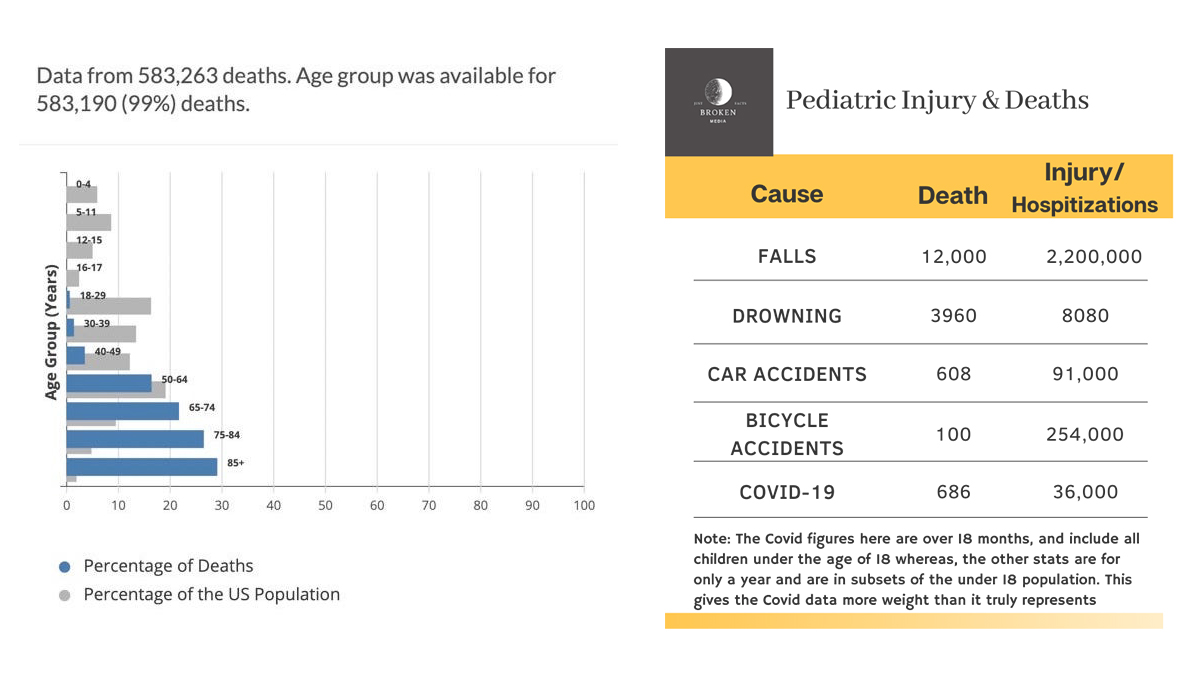Infection, Hospitalization, Fatality Rates in Children and breakdown in why the Media has failed you on these metrics.
By Emily Kaplan | Originally published Oct. 17, 2021 on Substack.
Covid-19 vaccines have been approved for children 12 years and older, approval under emergency use for children 5-11 years old is expected to come soon. California has mandated vaccines for all children 12 and older. The media is reporting that this is our best hope forward, that parents are desperate for these pediatric shots and anyone who doesn’t get on board is selfish. My goal with this series of newsletters focused on Covid vaccines for children is to offer some verifiable data points that the media seems to be missing or is flat out flubbing. I will address the media coverage in addition to the data. This is a loaded topic so I’m going to take my time and give you all the information I have so you can be better informed and make the appropriate choices for your family.
We are all protective of our children. We all want to go back to a time of normalcy for them. The point of this newsletter is not to tell you what to do, nor is it to back a certain policy or agenda, it is simply to supply data points that you can fact check yourself with the provided links to medical research and government data, so that you can make the most informed decision for your family. As a friend said to me: “When we start making medical decisions based on what’s best for other people, we stop practicing medicine and start practicing public health which is entirely politically driven; no one should make medical choices based on politics.” I couldn’t agree more and hope these data points help to inform your medical choices.
Let’s get into it.
What are the pediatric infection, hospitalization, fatality numbers?
The Media’s Narrative:
According to the Washington Post, “Many parents have been anxiously awaiting the coronavirus vaccine for young children, in some cases imploring pediatricians for the shots. “There are the folks saying: ‘Please, please, please give my kid the vaccine. Drop one on the floor. Don’t tell anybody,’ ” Christoph Diasio, a pediatrician in Southern Pines, N.C.”
Business Insider ran a nearly identical piece where parents were “pleading” to get their hands on the vaccine for their kids using The Washington Post’s account as its primary source (it used to be a big no no in journalism ethics to use another media outlet as a primary source, but that standard has gone out the window, leaving us in some sort of hellacious, Dante-esk circle of media sourcing echo chamber that creates the appearance of validation of an idea or phenomenon but is in fact only the replication of the original account), and The Atlantic ran a piece claiming parents were so desperate they were lying about their child’s age in order to get them jabbed.
The New York Times reports the children are also demanding pediatric vaccines, and this demand has become so great that we are rewriting medical consent laws.
“Last fall, the District of Columbia Council voted to allow children as young as 11 to get recommended vaccines without parental consent. The New Jersey and New York legislatures have bills pending that would allow children as young as 14 to consent to vaccines; Minnesota has one that would permit some children as young as 12 to consent to Covid shots.”
And if it seems odd that adolescents would be pushing so hard for legal reform, you might be interested to know that there was a campaign designed by the US government to target this demographic to help push Covid vaccines on this age group. See here from the report on “Vaccine Outreach” published by the US Dept of Health and Human Services.
“When the Pfizer vaccine was originally authorized for 12-17 year-olds, campaigns on social media further intensified, given that this population uses social media platforms heavily. According to a news report, the White House recruited influencers and celebrities to spread accurate information and influence the audience to get vaccinated. The “See Friends Again” on TikTok†is an example of a campaign implemented by grassroots organizations. The campaign partnered with content creators from minority groups to help ease apprehensions about the vaccine among the communities of color. Using the same platform, a state public health department launched a contest to encourage vaccination among young people before students go back to in-person learning.”
But, are teens and parents actually this desperate? Well it seems these influencing campaigns clearly had an impact, yet the numbers tell us a bit more: less than one third of parents want their kids ages 5-11 vaccinated for Covid, according to a national poll by the non-partisan Kaiser Family Foundation. The same Kaiser survey found:
“Nearly half (48%) of parents of children ages 12-17 say their child has received at least one dose of a vaccine. The share of parents who say they want to “wait and see” before getting their 12-17 year old vaccinated has decreased to 15%, down from 23% in July. Just 4% of parents say they will only get their teenager vaccinated “if their school requires it,” and one in five (21%) say they will “definitely not” vaccinate their child, similar to the share measured in previous months.”
In sum, far more parents are apprehensive about vaccinating their child than the media is making it seem. This is important because we know from the government guidance that the media, doctors and others have been told to push out the exact stories you’re hearing in the news. It seems the editors have left the building; leaving in their stead government talking points and press releases. The G has spent millions of dollars on at least two massive campaigns ( “We Can Do This” and “It’s Up To You”) working with the media and community authorities including religious leaders to convince you to get yourself and everyone in your family vaccinated. From the HHS report:
“Another large national campaign called “It’s Up To You” aims to make the public feel confident about the vaccine by providing the latest and accurate information, normalizing hesitancy, and answering important questions. The initiative is led by the Ad Council in collaboration among more than 300 major brands, media companies, community-based organizations, faith leaders, medical experts, and other trusted messengers.”
The Heartbreaking Anecdote:
In the lead up to vaccine approvals for children ages 5 to 12 and recent mandates by schools in California, we’ve heard heartbreaking stories of pediatric cases ripping through hospitals and more reports of younger hospitalizations. When we consider the emotional laden accounts, often void of an data or context, it is hard not to feel compelled for the cause, but I caution this is not the responsible way to determine your child’s medical care. You need context, absolute numbers and a deeper look at the impact of the pandemic on the children.
And if you feel like your news feed is filled with sad stories of kids getting Covid, that is also not an accident and it is not an accurate representation of the risk to American children. The below talking points, developed by UNICEF, have been distributed and implemented as “best practices,” to recipients of the government’s funded efforts to combat vaccine hesitancy. From those best practices, section 3.2 focuses on “Telling Stories”:
“Evidence suggests that humans are not good at understanding statistical probabilities. Indeed, when women were presented with facts that the probability of their child getting a vaccine preventable disease was much greater than the risks of a vaccine-related event, this had no significant effect on demand for vaccination [21]. Rather, women weighed the perceived severity of disease and the perceived risk of adverse events from a vaccine in deciding whether to vaccinate their child [21]. This suggests that messages employing narrative techniques highlighting disease severity are more effective than statistical facts. A qualitative analysis of a European pro-vaccine online hub found parental stories were consistently the most accessed content.”
This is not a suggestion, it is claiming women, specific, cannot comprehend data but they will respond to emotional accounts so the best strategy is to use fear-based tactics—not based in data—to convince them to vaccinate their children. I don’t know about you, but that’s about the most offensive shit I’ve come across in a long time. It makes me pretty angry to hear that our government is telling the media, our doctors, religious leaders, and others to manipulate our feelings in order to induce a specific outcome they’ve chosen for us. This should be a universally unacceptable playbook on how a government informs its citizenry.
The subtext here is horrifically sexist, but it is also suggestive of aggressively controlling people emotionally, rather than offering rational solutions to the problems at hand. I think we have to agree this strategy has been working, which is why I am committed to writing this newsletter and offering a place where we can look at the data. We deserve the data without the emotion. So without further adieu…
Now for the Data
“Nonintervention does not mean that nothing happens. It means that something else happens.” – Christopher Hitchens
According to the American Academy of Pediatrics, “The available data indicate that COVID-19-associated hospitalization and death is uncommon in children.”
The risk of an American child contracting Covid and being hospitalized is less than one in 2,500 (36,000 cases/73,000,000 kids = 0.0004).
If you filled a football stadium with 100,000 kiddos, over the last 18 months, 40 of them would be hospitalized with Covid.
The risk of an American child contracting Covid and dying is 0.0009 percent, or 9 out of 1 million. Nine children out of one million is infinitesimally small risk factor.
Kids are more likely to be hit by lightning, be killed in an avalanche, be wrongfully convicted of a crime, lose an appendage in a chainsaw accident when they’re older and they’re far more likely to become a New York Times best selling author or win an Oscar than die of Covid.
Here are the total number of positive tests and deaths of Covid since January 2020, according to the CDC, up to the publication of this newsletter on Oct 17, 2021.
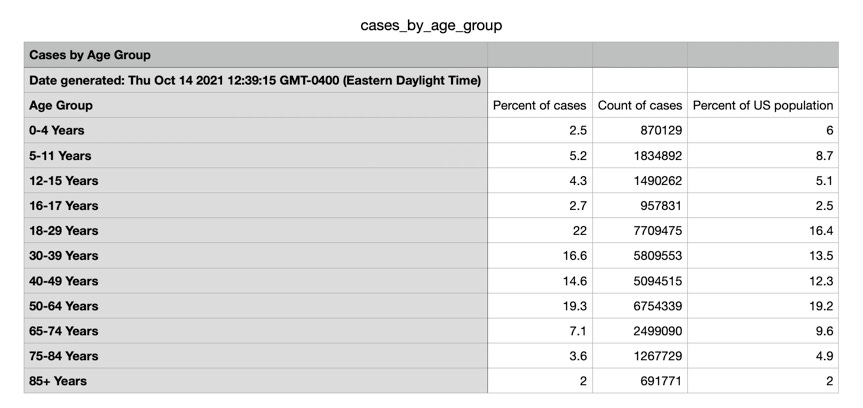
source: https://covid.cdc.gov/covid-data-tracker/#demographics
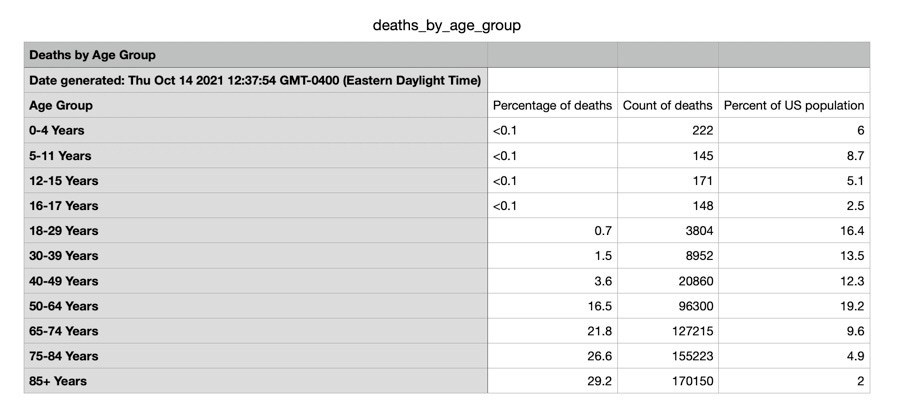
source: https://covid.cdc.gov/covid-data-tracker/#demographics
According to the CDC, the hospitalization and fatality rate of people under 18 is so low it does not appears on these charts.

Note, the fatality rate here lives around 0.
Since January 2020 there have been 686 deaths of children under the age of 18 years old, out of an estimated 73 million children.
The pediatric fatality rate and hospitalization rates (below) from Covid are statistically so insignificant we need to put them context.
More than 60,000 kids have died from other causes in this same period, according to the CDC. The leading cause of death for children is accidents, according to the CDC. Yet, we don’t see schools mandating swim lessons, bike lessons, working on balance to prevent falls or talking about driving safety to elementary students.

Yet, we’re hearing horror stories of pediatric hospitals overrun, so are there increased incidents of severe illness in children?
“At this time, it appears that severe illness due to COVID-19 is uncommon among children, American Academy of Pediatrics wrote on Oct 7, 2021.
“Since the pandemic began, children represented 16.3% of total cumulated cases. For the week ending October 7, children were 24.8% of reported weekly COVID-19 cases (children, under age 18, make up 22.2% of the US population). As of October 7, over 6.0 million children have tested positive for COVID-19 since the onset of the pandemic. The number of new child COVID cases remains exceptionally high. Over 148,000 cases were added the past week, with over 750,000 child cases added over the past 4 weeks.”
More kids are getting positive tests, but are they getting sick, being hospitalized, dying? Or are they getting this virus–like so many other viruses kids manage in the course of building a strong immune system–developing natural immunity, which is far superior to the vaccine, and moving on with their lives? (If you’d like to clear up any questions on natural immunity here is a list of 30 studies, including peer-reviewed press from Nature, JAMA, Cell, Lancet, etc confirming the superiority of natural immunity to the vaccines—another topic the press has failed to cover adequately).
And how is the media covering this?
Well, according to The New York Times report, A New Vaccine Strategy for Children: Just One Dose, for Now, “900,000 children have been hospitalized” with the virus since the start of the pandemic in early 2020. But that number turned out to be a complete fabrication. The actual number is closer to 63,000.
The Times got all of the key details in that story wrong, it was as if this reporter thought it was fine to just make up what fit her preconceived narrative. If she weren’t one of the main Covid reporters at The NY Times we could cut her some slack, but this is a regular problem. She is the reporter who tweeted out:
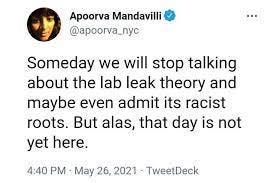
I cannot overstate this, it is literally her JOB to ask questions about the origins of Covid, without any editorializing. She is the primary reporter at The New York Times covering vaccines and she over-estimated pediatric cases by more than 14 times their actual rate. Her credibility and ability to speak truth to power has waned like an ineffective vaccine. (see what I did there :-)
The Times was forced to issue a massive correction on all these details. (They also had to apologize for her “racist” tweet.)
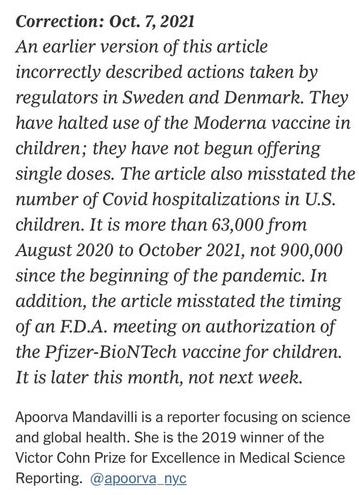
An important note on the 63,000 figure, it is hospitalizations for anything, and the date range extends from August 2020 to October 2021. This is odd on a number of levels. If you want to know the risk Covid poses to children you don’t really care about the kids who went to the ER with a broken leg, were swabbed due to the mandatory hospital protocols that everyone be tested, had a positive PCR and was sent home with a cast on their legs. You want to know how many kids were hospitalized FOR COVID. This commingling continues and makes it very difficult to account with accuracy for the absolute risk to kids. Likewise, there is no other illness that we measure and report on outcomes extending for more than 12 months. We do not report flu hospitalization and death as spanning 18 months, or years… but with Covid we do this. All covid statistics are measured in ongoing cumulative counts, rather than annual rates.
This messes with any ability to compare year-over-year data. Notice that note I put under the chart of accidental deaths above, it’s because the data for the Covid cases includes 18 months of deaths and incidence, whereas all the other causes are for a 12 month period. Imagine if we were keeping a cumulative count of flu deaths since 1918! That’s essentially what the media is doing here. So, the 63,000 hospitalizations is over 18 months and includes anytime a child went to the hospital and had a positive covid test, which has to be an overestimation of what we really want to know when considering the risk American children face, but for the sake of this newsletter series we will use this figure, because it’s the benchmark we have and frankly the numbers are so, so small anyway it just means the risk is ever less then teeny tiny.
But don’t take my word for it, there are at least two major studies that concluded the reporting of pediatric hospitalization have been grossly overestimating the number of cases that should be attributed to Covid. New York Magazine did a write up on both studies, this is from their findings:
“In one study, conducted at a children’s hospital in Northern California, among the 117 pediatric SARS-CoV2-positive patients hospitalized between May 10, 2020, and February 10, 2021, the authors concluded that 53 of them (or 45 percent) “were unlikely to be caused by SARS-CoV-2.” The reasons for hospital admission for these “unlikely” patients included surgeries, cancer treatment, a psychiatric episode, urologic issues, and various infections such as cellulitis, among other diagnoses…The study also found that 46 (or 39.3 percent) of patients coded as SARS-CoV2 positive were asymptomatic. In other words, despite patients’ testing positive for the virus as part of the hospital’s universal screening, COVID-19 symptoms were absent, therefore it was not the reason for the hospitalization.”
This makes it pretty clear that the 36,000 number is likely an overestimate, but again we’re using it knowing the numbers are likely even more in your kid’s favor. And this is likely true across the board, two Senators from Oregon have filed a grand jury petition calling for an investigation into alleged exaggeration of all Covid fatalities by the FDA and CDC.
To conclude, I’m just going to repeat what’s above, because it bears repeating given how little it’s been reported:
The risk of an American child contracting Covid and being hospitalized is less than one in 2,500 (36,000 cases/73,000,000 kids = 0.0004).
If you filled a football stadium with 100,000 kiddos, over the last 18 months, 40 of them would be hospitalized with Covid.
The risk of an American child contracting Covid and dying is 0.0009 percent, or 9 out of 1 million. Nine children out of one million is infinitesimally small risk factor. Kids are more likely to be hit by lightning, be killed in an avalanche, be wrongfully convicted of a crime, lose an appendage in a chainsaw accident when they’re older and they’re far more likely to become a New York Times best selling author or win an Oscar than die of Covid.
Emily Kaplan is an expert in strategy and communication. As the CEO and Co-founder of The Broken Science Initiative, she is building a platform to educate people on the systemic failings in science, education and health while offering an alternative approach based in probability theory. As the principal at The Kleio Group, Emily works with high profile companies, celebrities, entrepreneurs, politicians and scientists who face strategic communication challenges or find themselves in a crisis.
Emily’s work as a business leader includes time spent working with large Arab conglomerates in the GCC region of the Middle East looking to partner with American interests. Emily acquired Prep Cosmetics, expanded it to become a national chain and revolutionized the way women bought beauty products by offering novel online shopping experiences, which are now the industry standard. She was a partner in a dating app that used the new technology of geolocation to help interested parties meet up in real life. Emily developed Prime Fitness and Nutrition, a women’s health concept that focused on the fitness and diet needs of women as they age, with three physical locations. She was the host of the Empowered Health Podcast, and wrote a column in Boston Magazine by the same name, both of which focused on sex differences in medicine.
Emily is an award winning journalist who has written for national newspapers, magazines and produced for ABC News’ 20/20, Primetime and Good Morning America. She is the author of two business advice books published by HarperCollins Leadership. Emily studied Advanced Negotiation and Mediation at Harvard Law School. She has a Masters of Science from Northwestern University and received a BA in history and psychology from Smith College.
Support the Broken Science Initiative.
Subscribe today →
